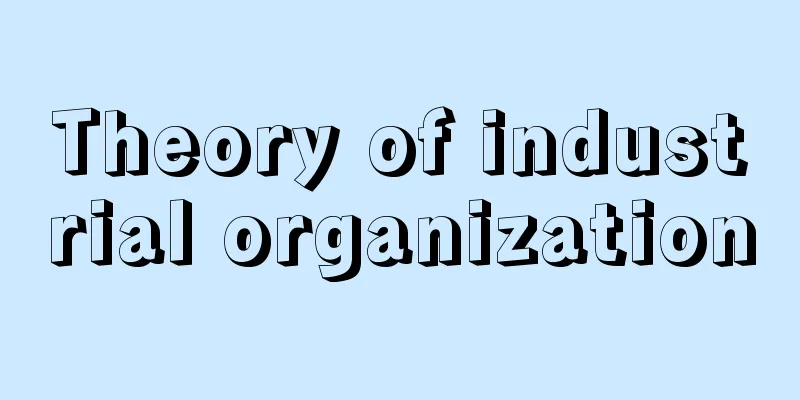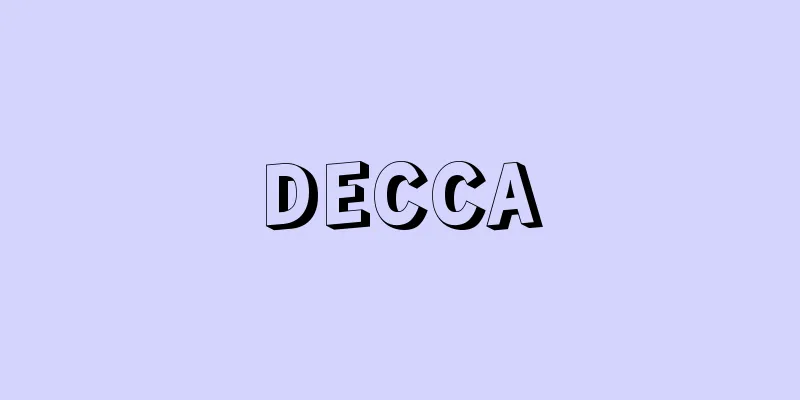Theory of industrial organization

|
When examining industrial activity, the term industrial structure is often used to refer to the combination of industries, while industrial organization refers to the structure between companies within an industry. An "industry" is made up of a group of companies that supply the same type of product to the market. Thus, industrial organization is a way of thinking that considers problems centered on the competitive relationships between companies within a market or industry for a specific market or industry. Industrial organization can be characterized by three aspects: (1) market structure, (2) market behavior, and (3) market outcomes. It is important to examine the state of these three aspects of the market structure, behavior, and outcomes surrounding companies, and determine what kind of public policy should be used to address any social problems. This is the task of industrial organization policy as a public policy for companies, such as antitrust policies and direct regulation of companies. [Kenichi Miyazawa] Market StructureMarket structure refers to the state of affairs between companies competing or cooperating in the market. The issue here is to determine whether the market structure in a particular industry is competitive, monopoly, oligopoly, or imperfectly competitive. There are various measures devised to indicate the characteristics of market structure, but the important ones are concentration, entry barriers, product differentiation, etc. "Concentration" refers to the proportion of production by various companies in a particular industry, and the higher the proportion of a small number of companies, the more oligopolistic the industry. "Entry barriers" refers to the degree of deterrence to other companies from entering the market, using means such as company size, cost differences, and patent rights. "Product differentiation" refers to the degree to which companies differentiate and distinguish their products from those of other companies through advertising, publicity, and other means in order to induce buyers' preferences, even when the products are the same. [Kenichi Miyazawa] Market ConductThe next point to be examined is how the above-mentioned differences in market structure affect the market behavior of companies. Market behavior refers to a company's pricing policy, product policy, and response policy toward competitors, and refers to the goal setting and method selection that a company pursues in the market. This can take the form of mutually independent behavior of companies, or conversely, agreements and cartels between companies, price leadership, outsiders, tacit understanding behavior, systematic information exchange, etc., but the criterion for judgment is the presence or absence of conscious parallel actions, collective actions, and collusive actions. Regarding profit pursuit, there is a distinction between independent profit maximization and joint profit maximization, and instead of profit maximization, it is also necessary to distinguish between types of goal setting, such as sales maximization, the full cost principle, and the goal of achieving both growth and safety. [Kenichi Miyazawa] Market ResultsAs a result of this market structure and market behavior, the issue of market performance is to determine the degree to which the market is producing desirable conditions. The general standard for the degree of market performance is whether the market is approaching the optimal allocation of resources, but at a more specific level, the following points are important. In terms of efficiency, the following points are technical efficiency, such as the appropriateness of the size and integration of factories and companies in production and the presence or absence of excess capacity, the degree of waste in sales costs and the degree of advertising and other non-price competition in distribution, and in terms of price, the efficiency of resource allocation, as reflected in the price-cost relationship or the presence or absence of excess profits and the degree of price flexibility. Furthermore, from a long-term and dynamic perspective, important criteria for judgment include the presence or absence of technological innovation and research and development capabilities, the quality and safety of products, and the degree of resource conservation. [Kenichi Miyazawa] Conditions for Effective CompetitionWhen the market structure is close to competitive, effective competitive behavior between companies can be expected to produce socially desirable results, but when the market structure is non-competitive or oligopoly, competition is likely to be virtually eliminated. Of course, competition is not always hindered in oligopoly markets. There are cases where large companies compete fiercely to secure the market during economic growth (competitive oligopoly). However, it is often the case that companies stop competing on price and try to coexist and prosper (cooperative oligopoly). In such cases, these industries tend to adopt a high-price, high-profit approach, which restricts the socially necessary movement of resources, resulting in the so-called negative effects of monopoly. The policy management under the "Antimonopoly Act" is a system designed to regulate this. The aim of antimonopoly policy is not to seek completely free and perfect competition. This is because dividing large companies into many small companies is not practical and creates negative effects that eliminate economies of scale and economies of organization. The goal is to achieve effective competition, restore the functioning of the price function, and maintain a flexible industrial organization. In terms of market structure, the criteria for effective competition include the number of companies, the presence or absence of price control, the possibility of entry by new companies, and market growth potential. In terms of market behavior, the presence or absence of collusion between companies and the presence or absence of cooperative behavior are used as indicators. In terms of market outcomes, the criteria include economies of scale, operating rate, advertising expense ratio, and the presence or absence of technological advancement, with the presence or absence of price flexibility also being an important indicator. The challenge is to achieve these effectively while balancing them with social conditions such as environmental conservation and ensuring product safety. [Kenichi Miyazawa] "Industrial Organization, Volumes 1 and 2, by J.S. Bain, supervised translation by Miyazawa Kenichi (1970, Maruzen)" ▽ "Industrial Economics, by Miyazawa Kenichi (1975, Toyo Keizai Shinposha)" ▽ "Modern Industrial Organization, by Imai Kenichi (1976, Iwanami Shoten)" ▽ "Industrial Organization, by Uekusa Masu (1982, Chikuma Shobo)" [References] | | |Source: Shogakukan Encyclopedia Nipponica About Encyclopedia Nipponica Information | Legend |
|
産業活動を点検しようとするとき、よく用いられる産業構造の語が産業間の組合せの様相をさすのに対して、産業組織の語は、産業内の企業間の構造を示すものとして用いられる。「産業」とは、同種の商品を市場に供給する企業のグループからなる。したがって産業組織論とは、特定の市場、特定の産業をめぐる、市場内部、産業内部における企業間の競争関係を中心に問題を考えるものの見方である。産業組織を特徴づけているものは、三つに仕分けできる。(1)市場構造、(2)市場行動、(3)市場成果、の3側面である。企業をめぐる市場の構造、行動、成果のこの3局面のあり方を調べ、社会的に問題があるときは、いかなる公共政策をもってこれをただすかの判定が重要となる。これが独占禁止政策や企業の直接規制など、企業に対する公共政策としての産業組織政策の課題である。 [宮澤健一] 市場構造市場構造とは、市場で競合し、あるいは協調する企業相互間のありようをいう。ここでの問題は、特定の産業における市場構造が、競争型のそれであるか、独占、寡占、不完全競争型のいずれであるか、その識別である。市場構造の特性を示す尺度には各種のものがくふうされているが、重要なのは、集中度、参入障壁、製品差別化などである。「集中度」とは、特定産業のなかに占める諸企業による生産割合で、少数企業が高比重を占めるほど、その産業は寡占型となる。「参入障壁」とは、企業規模、費用差、特許権などを手段とする、市場への他企業参入の阻止力の程度を表す。「製品差別化」とは、同種の製品でも、企業が買い手の選好を誘導すべく、広告、宣伝その他により他の企業の製品と差別、識別させている程度を示す。 [宮澤健一] 市場行動前記のような市場構造の差が、企業の市場行動にいかなる違いを生むかが、次に吟味を要する点となる。市場行動とは、企業の価格政策、製品政策、競争相手に対する反応政策などをいい、企業が市場において追求する目的設定や方法の選択のことをさす。それは、企業の相互独立的な行動、あるいは逆に企業間の協定やカルテル、さらにはプライス・リーダーシップ、アウトサイダー、暗黙の了解行動、系統的な情報交換等々の形をとるが、判断基準を与えるのは、意識的並行行為や集団行動、結託行動の存否である。利潤追求についても、独立利潤極大化か共同利潤極大化かの別があるし、また利潤極大化にかえて、売上高極大化、フルコスト原理、成長と安全性の両立目標など、目的設定の型についても識別を要する。 [宮澤健一] 市場成果こうした市場構造と市場行動の結果として、市場がどの程度の望ましい状態を生んでいるかを判別するのが、市場成果の問題である。その程度の一般的基準は、市場が資源の最適配分に近づいているか否かにあるが、もうすこし具体的なレベルでは、次の点が重要である。すなわち、効率性の面からは、生産面での工場・企業の規模や統合の適正度、過剰能力の有無などの技術的効率いかん、流通面での販売費用の浪費度、広告その他の非価格競争の程度、価格面では、価格―費用の関係ないし超過利潤の存否、価格伸縮性の程度に現れる資源の配分効率いかんである。さらに長期・動態面からは、技術革新力や研究開発力の存否、製品の品質や安全性、資源保全の程度などが重要な判断基準となる。 [宮澤健一] 有効競争の条件市場構造が競争型に近いと、企業間で有効な競争行動がとられ、社会的に望ましい成果が期待できるが、市場構造が非競争型・寡占型となると、競争は実質的に排除されやすくなる。もちろん、寡占型の市場でつねに競争が阻害されるというわけではない。大企業間で経済成長下などで激しい市場確保の競争がなされる状況が生ずる場合もある(競争的寡占)。しかし、しばしば各企業が互いに価格競争をやめて、共存共栄を図ろうとする状況が支配的となることも多い(協調的寡占)。そうしたとき、これら産業では高価格・高利潤方式がとられがちであり、資源の社会的に必要な移動が制限されるという、いわゆる独占の弊害が生じる。これを規制するための制度設計が「独占禁止法」による政策運営である。独占禁止政策のねらいは、まったく自由で完全な競争を求めることにあるのではない。大企業を多数の小企業に分割することは実際的ではないし、規模の経済性や組織の経済性を失わせるマイナス効果を生むからである。目標は、有効競争を実現して、価格機能の働きを取り戻し、柔軟性ある産業組織を維持することにある。有効競争の基準は、市場構造の面では、企業数、価格支配力の有無、新規企業の参入の可能性、市場の成長性などに求められる。市場行動の面では、企業間の結託の有無、協調的行動の有無などが目安とされる。市場成果の面では、規模の経済、操業度、広告費比率、技術進歩の有無などが基準となり、価格の伸縮性の有無も重要な目安となる。これらを、環境保全、製品安全性確保などの社会的条件と両立させつつ、有効に実現させることが課題である。 [宮澤健一] 『J・S・ベイン著、宮澤健一監訳『産業組織論』上下(1970・丸善)』▽『宮澤健一著『産業の経済学』(1975・東洋経済新報社)』▽『今井賢一著『現代産業組織』(1976・岩波書店)』▽『植草益著『産業組織論』(1982・筑摩書房)』 [参照項目] | | |出典 小学館 日本大百科全書(ニッポニカ)日本大百科全書(ニッポニカ)について 情報 | 凡例 |
Recommend
Investment in China
This refers to investment in China, but historical...
Perpetual bonds - Eikyukousai
Perpetual government bonds have no maturity date....
Calantica cos (English spelling) Calanticacos
...Red ginger S. rubrum grows to about 3cm, its h...
Gion no Nyōgo Kokonoe Nishiki
Joruri. Historical piece. Five acts. A collaborati...
Matsuzakaya Co., Ltd. - Matsuzakaya
It started as a kimono merchant Ito-ya, founded in...
Indonesian Communist Party (English name) Partai Komunist Indonesia
A political party in Indonesia. Founded on May 23,...
Vault - Safe
...Various mechanisms are used to protect against...
Scutellaria indica; skullcap
A perennial plant of the Lamiaceae family, it is w...
Schmidt, JK (English spelling) SchmidtJK
…German philosopher belonging to the left of Hege...
Kuhei Kaneko
1895-1968 A sculptor from the Taisho and Showa pe...
Taoryu Hills - Yurugi Hills
A hill in the south-central part of Kanagawa Prefe...
Purple dye murex
...It is carnivorous and feeds on the flesh of de...
Zhao Mengfu - Cho Mofu
He was a Chinese government official, calligraphe...
Theology - Shingaku
An academic field that discusses the content, obj...
《Kritische Theorie》(English)
…He worked to establish the foundations of “criti...









